Mount Rainier National Park: 12 Landscape Photographs Made with a Hasselblad Digital Back and Technical Camera

Mount Rainier National Park offers a diverse range of photographic opportunities, from expansive landscapes to intimate natural details. For this series of images, I used a technical camera setup: an Arca-Swiss Rm3di combined with a Hasselblad CFV 100C digital back. This equipment was paired with a selection of Schneider, Rodenstock, and Nikkor technical camera lenses, each chosen for its specific optical characteristics.
These images were created during Mike Wardynski's Mount Rainier photography workshop . Mike's approach emphasizes wide-angle perspectives and careful observation of light quality. While my widest lens, at the time, was the APO-Digitar 35mm on medium format (28mm equivalent in full-frame terms), working within this constraint led to some of my strongest wide-angle compositions. Mike's hands-on approach to composition coaching proved invaluable throughout the workshop.
Mike's thorough knowledge of the park translated into practical advantages for workshop participants. By arriving well before other photographers each morning, he ensured everyone had their choice of composition locations - a particularly valuable consideration when choosing which workshop to join.
The technical camera system provides precise control over perspective and focus. This control is particularly useful in landscape photography, where it's often desirable to have sharp focus from foreground elements to distant subjects. By applying tilt-shift techniques and the Scheimpflug principle, it's possible to achieve an extended depth of field that encompasses both nearby objects and faraway scenery.
This collection of twelve photographs showcases various locations within Mount Rainier National Park, from the subalpine meadows of Paradise to the rushing waters of Christine Falls. Each image aims to present a clear view of the park's natural features, captured through different lenses that offer their own perspective on the landscape. The following sections will present these photographs, along with technical notes on how they were made.
Images made with the Schneider-Kreuznach Apo-Digitar 5.6/35 XL Lens
The Schneider-Kreuznach Apo-Digitar 5.6/35 XL is a wide-angle lens known for its exceptional sharpness and minimal distortion. With a 35mm focal length, it provides a generous field of view, ideal for capturing expansive landscapes while maintaining excellent detail from corner to corner. This lens is particularly effective in situations where both foreground interest and distant subjects need to be rendered with clarity, making it well-suited for the diverse scenery of Mount Rainier National Park.
While the published image circle is 90mm, care must be taken when shifting. One of the lens's strengths is its symmetrical design, which makes it excellent for imagery with straight lines, such as architecture. However, this design requires the lens to be very close to the camera sensor, which can lead to issues with noise and color cast.
For optimal image quality, it's recommended to limit shift movements to no more than 10mm and always create a reference LCC (Lens Cast Calibration) image for later calibration. This approach helps maintain image quality while still taking advantage of the lens's capabilities.
There is a center filter available for this lens, the Schneider M 52 IIF for Apo Digitar 5.6/35 XL, which helps address the extreme light falloff associated with it. The decision to use this filter involves a trade-off: while it evens out the exposure, it also results in a loss of two stops of light. Photographers may find themselves alternating between using and not using the center filter depending on the specific requirements of each shot.
It's worth noting that the Schneider-Kreuznach Apo-Digitar 5.6/35 XL is only available on the used market.
1. Mount Rainier from Paradise
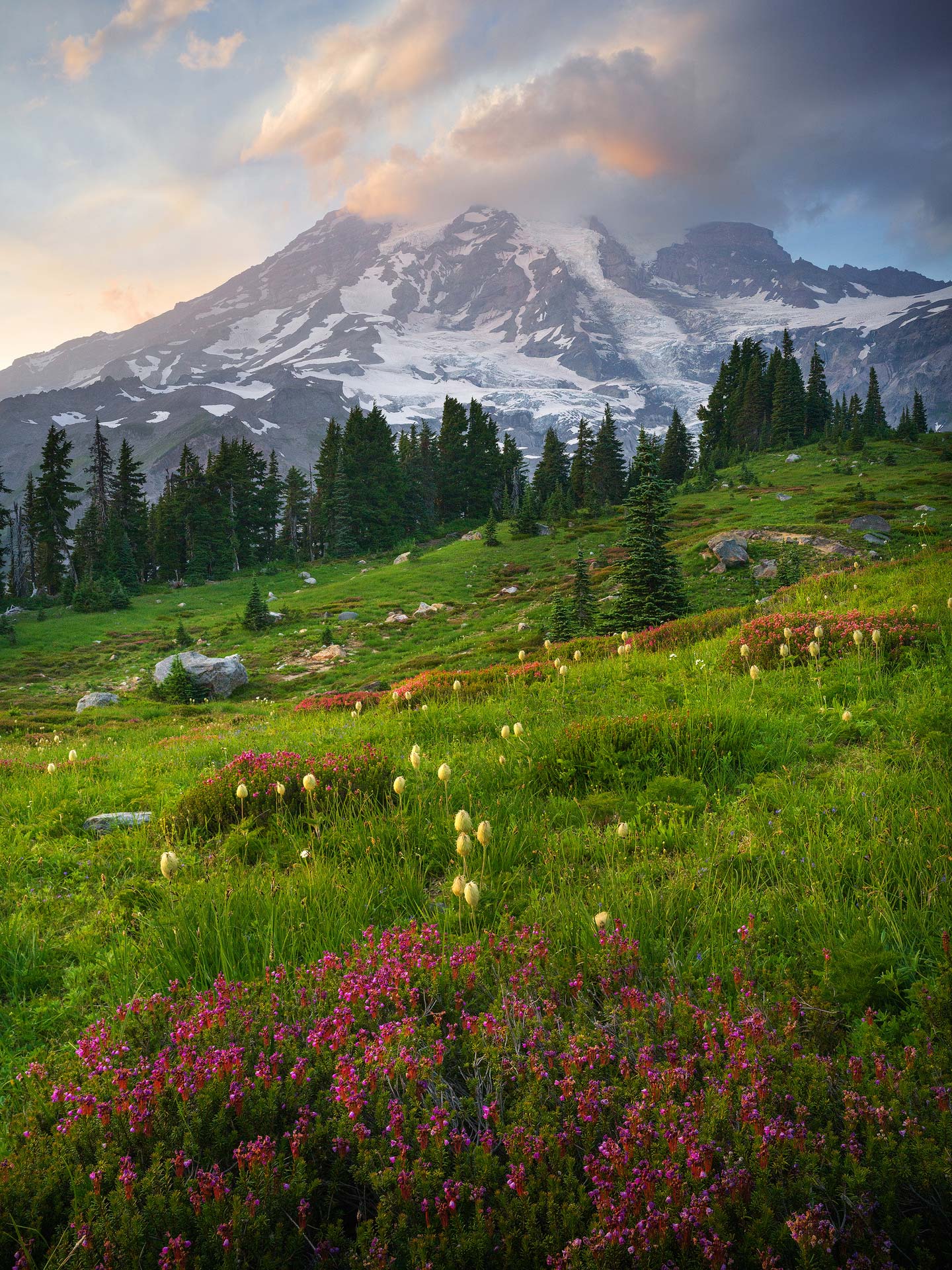
The warm light highlights the subalpine features of this image made during sunset in Paradise. The peak of Mount Rainier covered by clouds dominates the background.
The foreground showcases a meadow filled with wildflowers. Pink Mountain Heather creates colorful patches throughout, while the white, fluffy blooms of Western Anemone add variety to the green meadow. Evergreen trees in the middle ground provide a natural transition to the mountain.
To keep both the delicate foreground flowers and the distant peak in focus, the image was made using tilt-shift techniques, applying the Scheimpflug principle. This approach allows the photo to capture the full depth of the scene, from the nearby meadow to the imposing mountain.
2. Paradise River
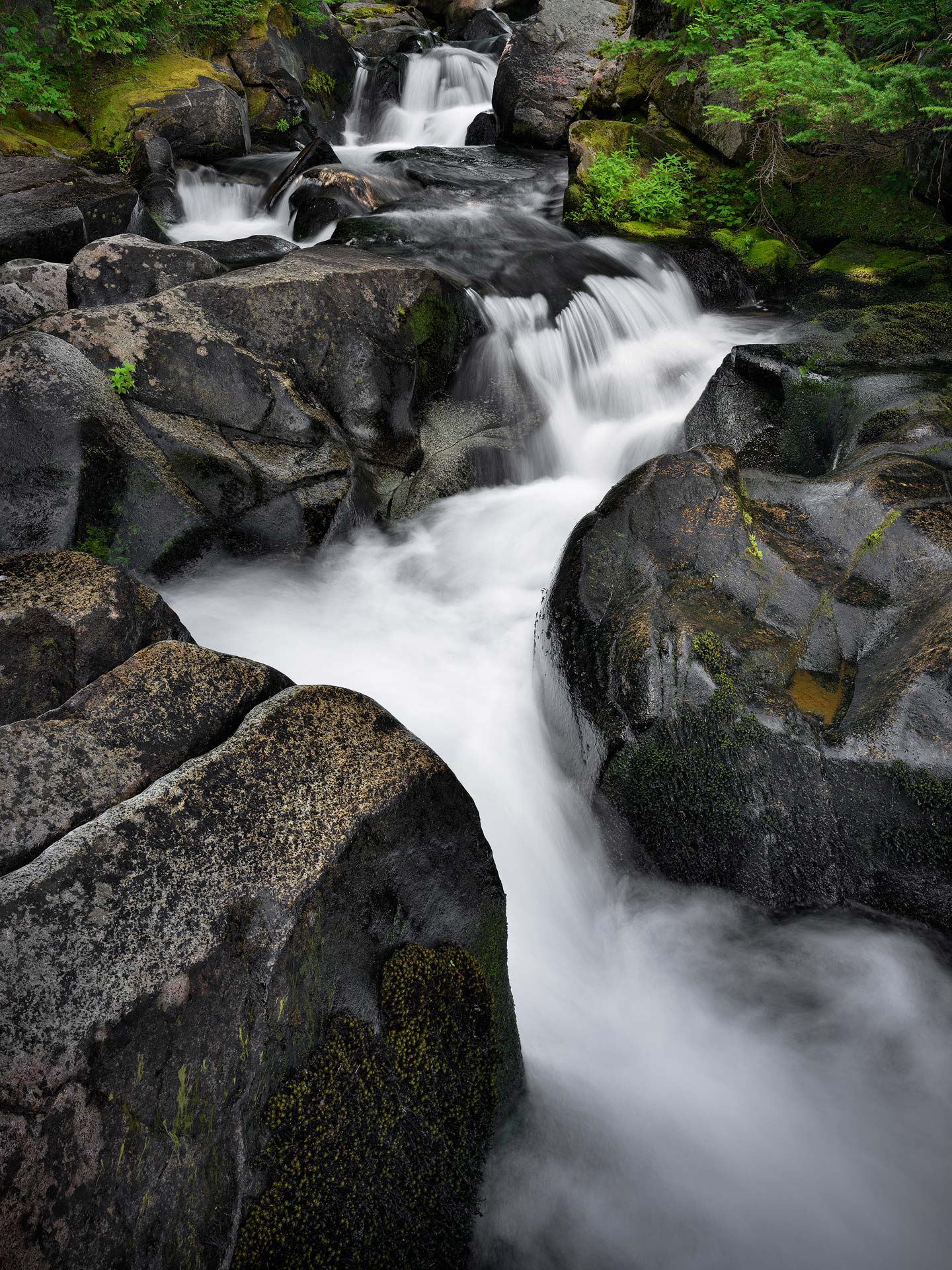
This image showcases an intimate scene of the Paradise River as it cascades over and around large boulders. Hints of green moss and surrounding vegetation add subtle color to the predominantly gray and white scene, typical of the park's lush environment.
Long exposure techniques render the water as smooth, silky streams, contrasting with the solid, textured surfaces of the boulders. Like the previous image, this one was made using tilt-shift techniques including the Scheimpflug principle to maintain focus and about 5mm of camera rise to include more of the foreground in the composition.
3. Mount Rainier Reflected in Reflection Lake
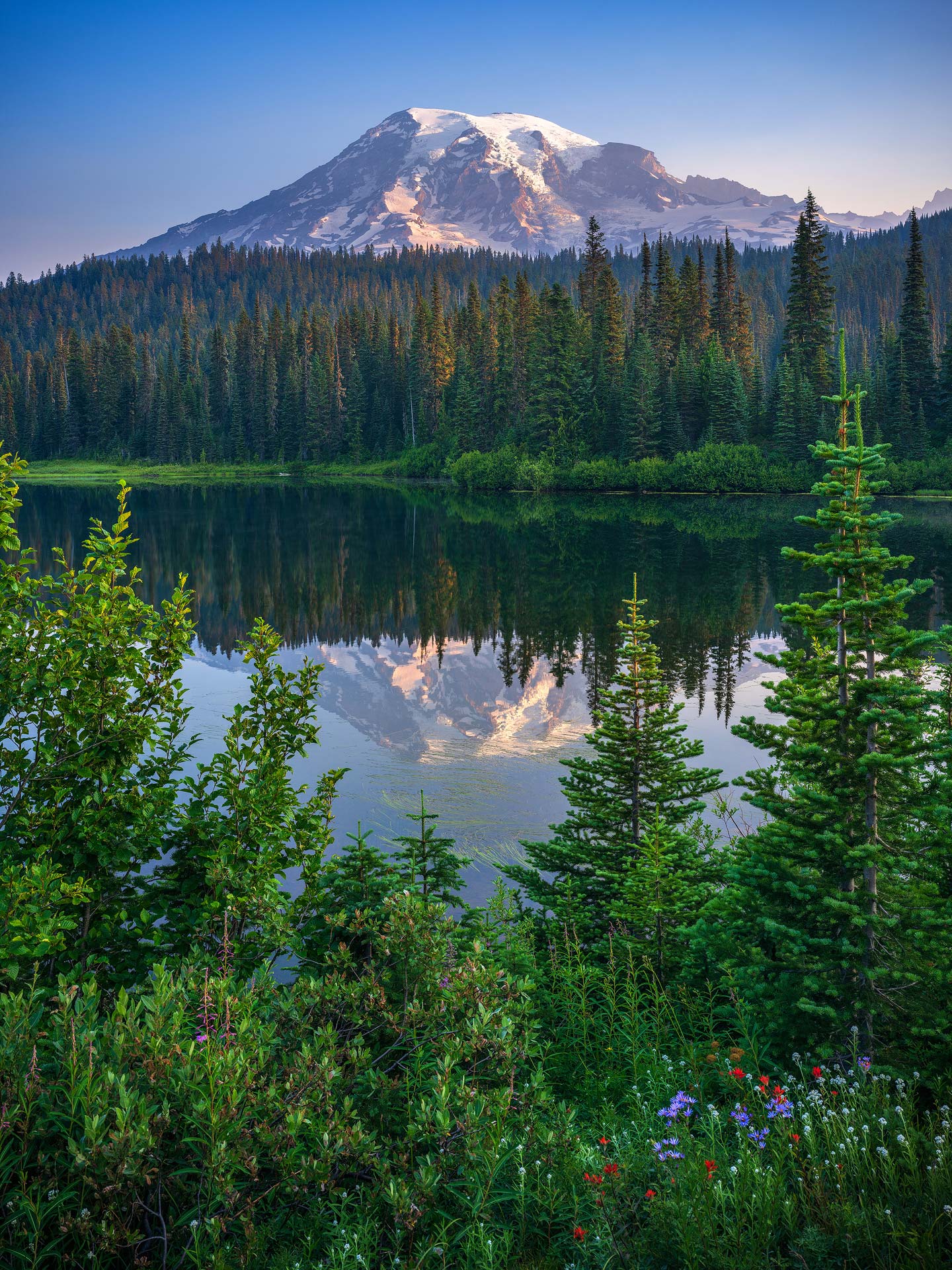
This image was made at sunrise on the final morning of my trip to the park. The early light had just begun to illuminate the evergreen trees in the midground.
Mount Rainier, an active stratovolcano standing at 14,411 feet, dominates the scene. Its snow-capped summit and glaciers are mirrored in the lake's still surface.
In the midground, a dense forest surrounds the lake, primarily consisting of subalpine fir and mountain hemlock. These evergreens create a distinct border between the water and the mountain slopes.
In the foreground, a few wildflowers add touches of color. Indian Paintbrush and Aster flowers provide subtle red and blue hues in the bottom right corner. Their sparse presence suggests this was towards the end of the wildflower season in the park.
The clear, pale blue sky and warm morning light on the mountain showcase the natural beauty of the Pacific Northwest.
Images made with the Rodenstock HR Digaron-W 50 mm f/4.0 Lens
The Rodenstock HR Digaron-W 50 mm f/4.0 is a versatile lens that strikes an excellent balance between wide-angle and standard focal lengths. Renowned for its exceptional sharpness and low distortion, this lens is particularly well-suited for landscape photography.
Its 50mm focal length provides a natural perspective that closely mimics human vision, making it ideal for creating images with a strong sense of depth and scale. This characteristic allows photographers to capture scenes in a way that feels familiar and immersive to viewers.
One of the standout features of the Digaron-W 50 mm lens is its generous 90mm image circle. This large coverage area enables significant shift movements and facilitates panorama stitching without any loss in image quality. These capabilities make the lens a favorite among many photographers, especially those who frequently work with technical cameras or create large-format panoramas.
The Rodenstock HR Digaron-W 50 mm f/4.0 is still available through high-end photography dealers like Capture Integration . When investing in a lens of this caliber, it's beneficial to consult with an expert on the subject. These specialists can provide valuable insights into the lens's capabilities and limitations, helping you make an informed decision. Additionally, purchasing through such dealers often comes with the advantage of ongoing support should any issues arise, ensuring you can make the most of your investment.
4. Creek and Subalpine Meadow

This view of Mount Rainier from Paradise Valley captures the essence of the national park. In the foreground, Edith Creek tumbles over rocks, its water smoothed by a long camera exposure. The creek gives way to lush subalpine meadows dotted with wildflowers and evergreens.
Mount Rainier itself commands the background, its snowy peak tinged with the warm light of sunset.
The image was created by stitching together two vertical photographs. This technique allows for a compressed perspective using a longer focal length while maintaining a wide-angle view. It brings Mount Rainier visually closer to the foreground elements, emphasizing both the grand scale of the mountain and the details of Edith Creek.
5. Myrtle Falls in the Paradise Valley

This image captures Myrtle Falls in the Paradise Valley of Mount Rainier National Park. It was made during twilight, before direct sunlight reached the landscape.
Mount Rainier dominates the background, its snow-covered peak beginning to show a warm glow as daylight approaches. In the foreground, Myrtle Falls cascades over rocky cliffs, framed by evergreen trees. A wooden footbridge spans the stream above the falls, adding a touch of human presence to the natural scene.
The image was created by stitching together three horizontal photographs. This technique allows for a compressed perspective using a longer focal length while maintaining a wide-angle view. It brings Mount Rainier visually closer to the foreground elements, emphasizing both the grand scale of the mountain and the details of Myrtle Falls.
6. Christine Falls
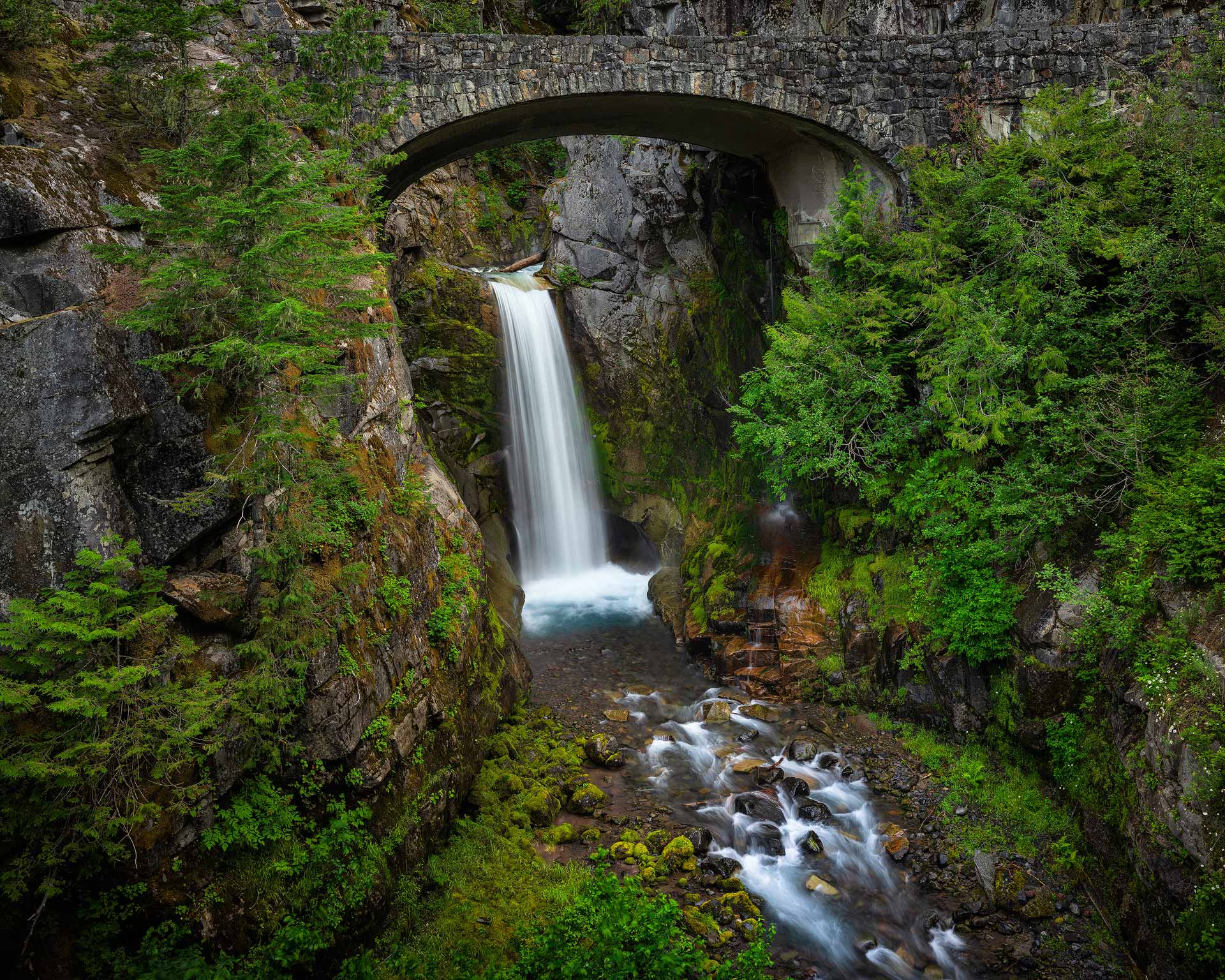
This photograph captures Christine Falls, a 60-foot plunging waterfall framed by a historic arched bridge, where Van Trump Creek flows through a narrow canyon between Rampart Ridge and Cushman Crest. The image is composed of four horizontal images stitched together, a technique that compresses the scene and brings the intricate details of the falls and surrounding landscape closer to the viewer while maintaining a wide-angle perspective.
7. Tatoosh Range and Paradise Valley
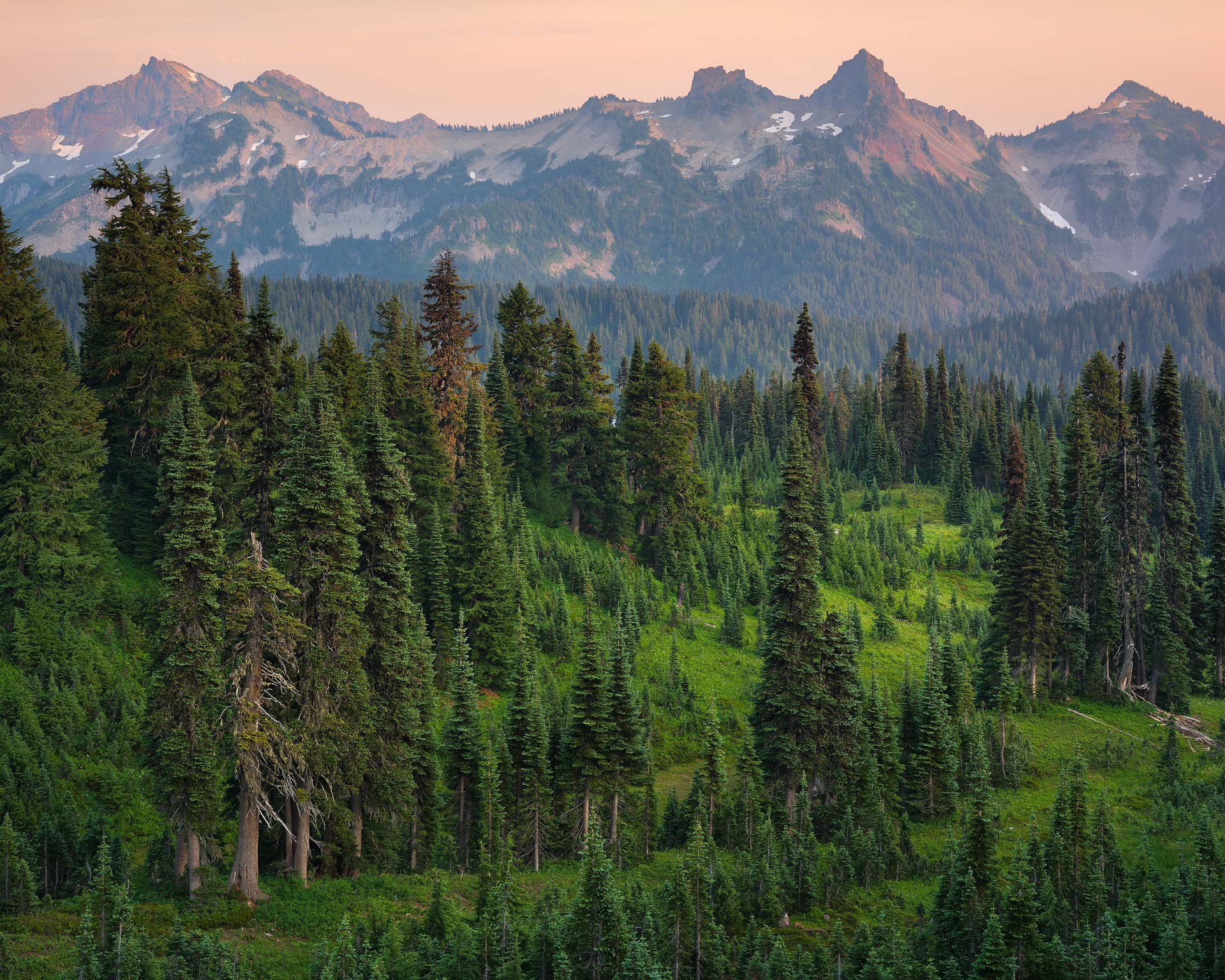
Looking down over Paradise Valley, you'll see the Tatoosh Range rising in the distance. The foreground is filled with evergreen trees arranged almost like a well-tended garden, giving the scene a slightly fantastical quality.
The jagged peaks of the Tatoosh Range dominate the background, their rocky summits tinged pink and orange by the setting sun. This warm light creates a soft contrast between the lush forest and rugged mountains, showcasing the park's diverse landscapes.
Images made with the Rodenstock HR Digaron-W 70 mm f/5.6 Lens
The Rodenstock HR Digaron-W 70 mm f/5.6 occupies an intriguing position in the world of focal lengths. While it's typically considered a telephoto lens when used with 35mm full-frame digital cameras, it takes on more of a normal to long normal focal length characteristic when paired with a medium format camera like the Hasselblad CFV 100C used in this project.
This versatility makes the 70mm lens particularly valuable for landscape photography, as it often provides an ideal balance between detail and context. It's wide enough to capture a substantial portion of a scene, yet long enough to exclude distracting elements and focus on the most compelling aspects of the landscape.
Like its wider counterpart, the Rodenstock HR Digaron-W 70 mm f/5.6 is available through high-end photography dealers such as Capture Integration. When considering this lens, it's worth consulting with experts who can provide insights into its specific capabilities and how it might complement your existing kit.
8. Water Carved Stone
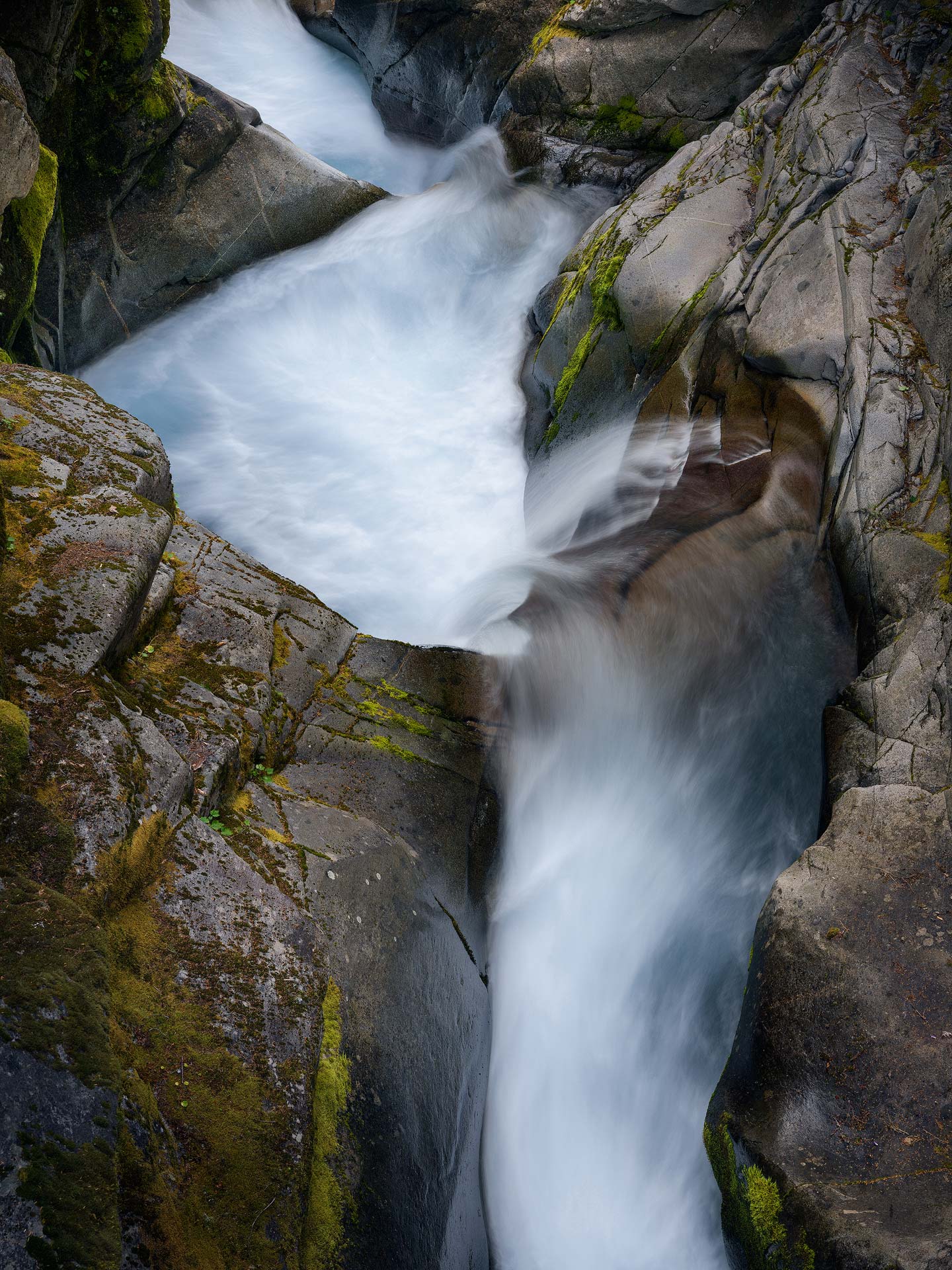
The image shows a creek in Mount Rainier National Park from above. The water flows through a narrow channel of rocks, which have been shaped over time by the water's erosion. Moss and lichen grow on the rocks, adding green accents to the gray stone.
A long exposure technique was used to capture the water's movement, resulting in a smooth, white appearance of the flowing water that contrasts with the solid rock surfaces.
Images made with the Schneider-Kreuznach Apo-Digitar 5.6/120 asph. Lens
The Schneider-Kreuznach Apo-Digitar 5.6/120 asph. is widely regarded as one of the finest lenses ever crafted for digital photography. Its exceptional qualities stem from a combination of innovative design features and versatile performance characteristics:
- Large Image Circle: With an impressive 150mm image circle, this lens offers extensive room for movements, crucial for perspective control and creative framing in technical camera systems.
- Aspherical Design: The aspherical lens elements contribute to its versatility, allowing it to excel in both close-up macro photography and capturing distant subjects. This design ensures exceptional clarity and detail across its entire focusing range.
- Compact and Lightweight: Despite its powerful capabilities, the lens maintains a remarkably compact and light form factor, making it an ideal companion for field work where mobility is key.
The 120mm focal length provides a moderately telephoto perspective, which brings several advantages to landscape photography:
- Compression: It allows for a more compressed perspective, visually bringing distant elements closer to the foreground. This effect can create a sense of intimacy even with far-off landscapes.
- Isolation: The lens excels at isolating specific features within a scene, allowing photographers to emphasize particular elements of interest.
- Graphic Quality: The combination of compression and isolation capabilities makes this lens particularly adept at creating images with strong graphic qualities, emphasizing shapes, lines, and patterns in the landscape.
It's worth noting that the Schneider-Kreuznach Apo-Digitar 5.6/120 asph. is now only available on the used market. Its reputation for quality and versatility has made it a sought-after item, often commanding high prices when it does appear for sale. Interested photographers can occasionally find this lens on specialized photography forums with buy/sell sections or on platforms like eBay. However, due to its rarity and value, patience and diligence are often required to secure one.
9. Sunset Silhouette of Mount Rainier

This photograph portrays Mount Rainier at sunset, with silhouetted trees in the foreground and mountains in the midground. As the sun sets in front of the camera, it casts a vibrant orange light on the peak, accentuating the mountain's dramatic profile against the evening sky. The contrast of the dark landscape and the backlit summit offers a peaceful moment to appreciate the grandeur of the park.
Images made with the Nikkor M 200mm f/8 S Lens
The Nikkor M 200mm f/8 S is a lens with a fascinating history and surprising versatility. Originally designed for 4x5 film cameras, it has found new life in the digital age, proving that well-designed optics can transcend their original medium.
Key characteristics of the Nikkor M 200mm f/8 S include:
- Exceptional Sharpness: Known for its ability to render fine details on film, this lens maintains its reputation for sharpness when used with digital sensors.
- Adaptability: While not all film-era lenses transition well to digital use, the Nikkor M 200mm f/8 S is a notable exception, performing admirably on modern digital camera systems.
- Value: Available on the used market for under $1000, it offers excellent performance at a fraction of the cost of many modern digital-specific lenses.
- Compact Design: At 200mm, it represents the longest focal length achievable in a small, compact lens mounted in a Copal 0 shutter suitable for technical cameras.
My personal experience with this lens has been overwhelmingly positive. I initially acquired it as a potential replacement for a 180mm digital lens, attracted by the slightly longer focal length and the competitive price point. In rigorous testing and field use, I found that the Nikkor matched or exceeded the performance of the digital lens in terms of sharpness and image circle. Given that the digital lens was priced 3-4 times higher, the decision to keep the Nikkor and sell the digital lens was straightforward.
In landscape photography, the 200mm focal length offers several advantages:
- Highly Compressed Perspective: This makes it ideal for isolating distant subjects and emphasizing the layering of elements in a landscape.
- Abstract Compositions: The narrow field of view allows for the creation of abstract compositions, focusing on patterns, textures, and details that might be lost in wider shots.
- Intimacy with Distant Subjects: It enables the capture of intimate portraits of far-off landscape features, bringing them into prominence.
While it may not be the most frequently used lens in a landscape photographer's kit, the Nikkor M 200mm f/8 S offers unique creative possibilities. Its ability to compress perspective and isolate subjects can lead to striking images that stand out from more conventional landscape compositions.
10. Waterfall in Paradise Valley
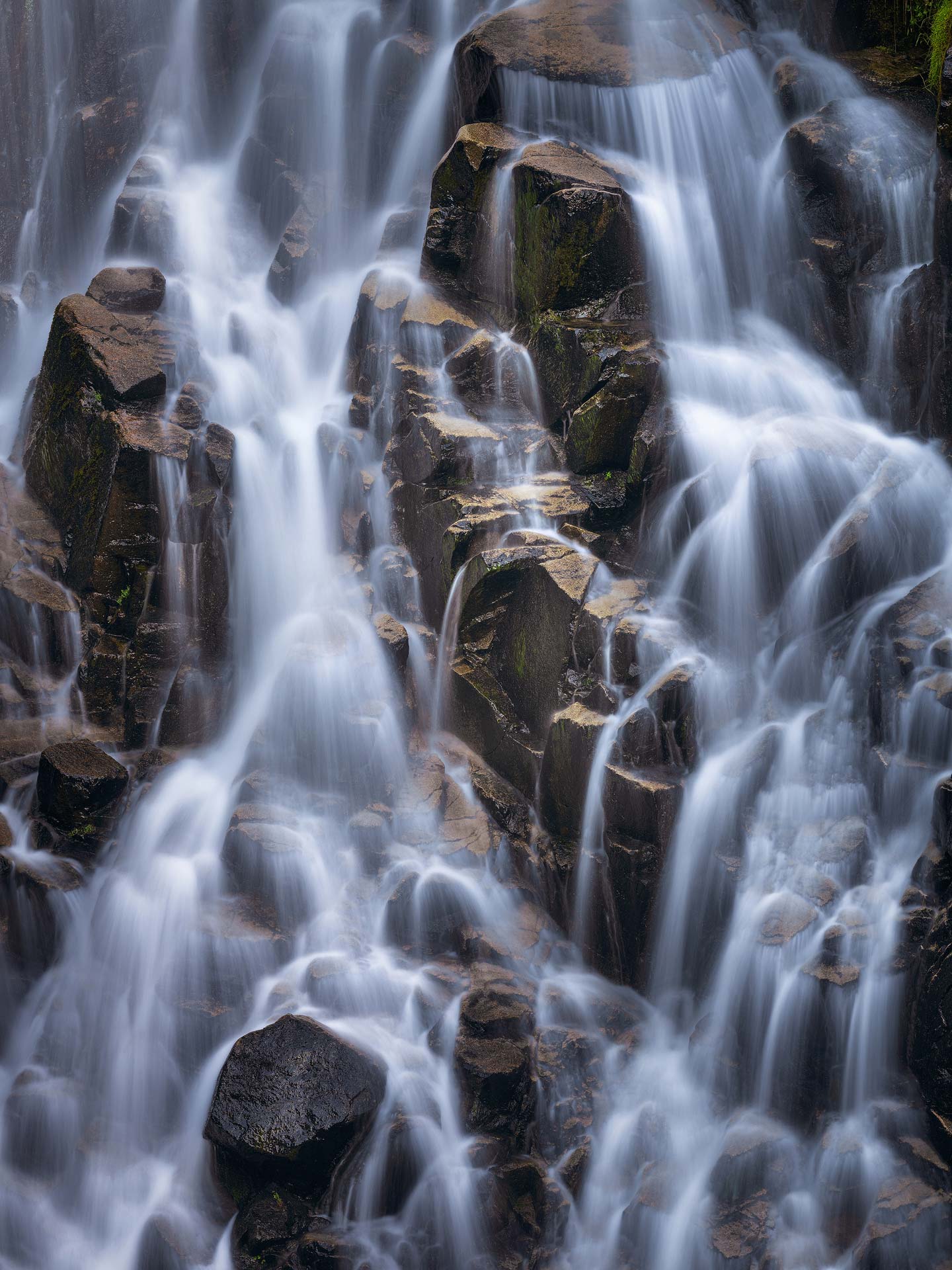
This photograph captures an intimate view of a waterfall in Paradise Valley, focusing on the water cascading over the brown rocks. The long exposure technique imparts a smooth, ethereal quality to the water, enhancing the abstract nature of this scene.
11. Morning Light Gradient
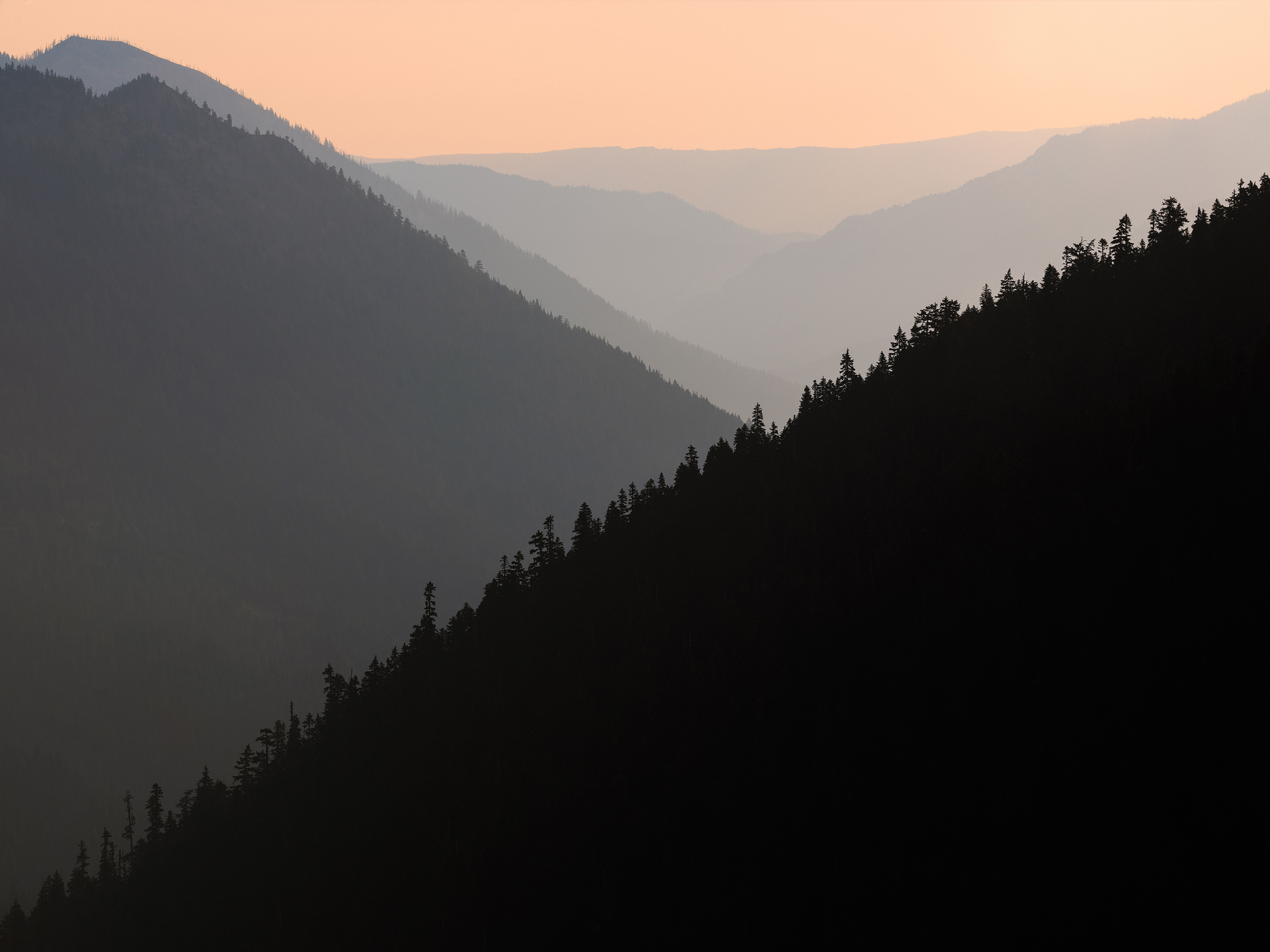
This photograph captures the gentle gradient of hills as they fade into the distance, highlighted by the soft light of early morning. The use of a telephoto lens compresses the scene, bringing the distant mountains closer together, which enhances the simple, clean lines and creates a strong graphic quality. Each layer is distinguished by subtle shifts in tone and shadow, emphasizing the natural contours of the landscape.
12. Twilight Grove

This photograph, made after sunset during the blue hour in Paradise Valley, captures a small grove of trees set against the towering mountain face in the background. The telephoto lens compresses the scene, bringing the distant mountain closer and emphasizing the contrast between the lush greenery and the purple hues of the rocky backdrop. The soft, diffused light casts a gentle glow over the trees, giving them a proud and almost otherworldly presence, reminiscent of a mythical grove hidden within the mountains.
Closing Thoughts on Using a Technical Camera for Landscape Photography in Mount Rainier National Park
Photographing Mount Rainier National Park presents both technical and creative challenges due to its diverse landscapes and varying lighting conditions. This collection of twelve landscape photographs aims to showcase different aspects of the park's natural features, from expansive vistas to more intimate scenes.
The use of a range of lenses, from the wide-angle Schneider-Kreuznach Apo-Digitar 5.6/35 XL to the telephoto Nikkor M 200mm f/8 S, allowed for the capture of varied perspectives. Each lens brought its own strengths to the task:
- The 35mm lens provided a broad view, useful for capturing expansive landscapes.
- The 50mm and 70mm lenses offered a balance between wide views and more focused compositions.
- The 120mm and 200mm lenses allowed for the isolation of specific elements and the creation of more abstract images.
Beyond the technical aspects of photography, Mike Wardynski's workshop offered unique opportunities to experience Mount Rainier National Park. During off-hours, Mike led participants on hikes simply for the joy of exploring - without cameras - providing a deeper appreciation for the landscape we were photographing. This balanced approach to both photographic technique and natural immersion enhanced the overall experience of capturing these images.
The technical camera system used in this project provided precise control over perspective and focus. This control was particularly useful in situations requiring extended depth of field, such as capturing both nearby wildflowers and distant mountain peaks in a single frame.
The images in this collection range from wide views of Mount Rainier to close-ups of water-carved stones. They include scenes from various locations within the park, including Paradise Valley, Reflection Lake, and Christine Falls. Each photograph attempts to present a clear view of the park's natural features, whether it's the pattern of subalpine meadows, the flow of glacial rivers, or the interplay of light and shadow on the mountain slopes.
This project represents one photographer's exploration of Mount Rainier National Park. It's part of an ongoing process of learning and refining techniques to effectively capture and present the natural world through photography. As with all creative endeavors, there's always room for improvement and new perspectives to be discovered in future visits to this remarkable location.

 Fashion Gray
Fashion Gray Crimson
Crimson Deep Yellow
Deep Yellow Tech Green
Tech Green Black
Black Purple
Purple Blue Jean
Blue Jean Blue Jay
Blue Jay Orange
Orange Primary Red
Primary Red Super White
Super White